bkill
Quest for the Two Headed Trout
It seemed like a simple plan..Take advantage of the recent heavy rains and spend the weekend on the Beaverkill, Willow and East Branch..The Beaverkill hit 16,000 cfs this past Wed but as always, it dropped like a rock and was running 1200 cfs when I arrived Sat afternoon..The only problem was it looked like chocolate milk..There was alot of damage and erosion on the upper Beaverkill...Rt 206 was closed due to the flooding...The East Branch wasnt much better, so my options were the West Branch or the Willowemoc..The Willow was running high and slightly off color but very fishable...I stopped by a friends house and convinced him to go fishing...We hit the the Willow around 6:30. There was very little bug activity but the fish were hungry and hitting big dries...We both landed a few nice fish and lost quite a few in the heavy water..
The next morning the Beaverkill was still running brown, so I hit the no-kill section on the Willow...Again the fish were cooperative in the heavy water..I was fishing a high floating size 12 attractor with a beadhead Pheasant tail dropper...I missed a few fish in the fast water, and landed a few nice owns before lunch..It was equal between the dry and the nymph but I landed more that were hooked with the nymph...Black Clouds and Lightning chased me off the river, so I took refuge in the Catskill Flyfishing Museum and it was a good choice because I was stuck there for at least a 45 minutes as the skies just opened up...
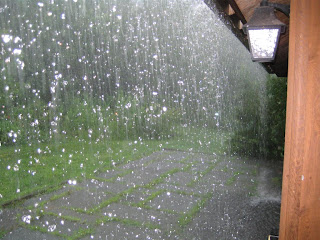
We were wishing for rain, but this is just too much!

The Museum
Afterwards the Lower Willowemoc was unfishable, all the tribs were dumping liquid mud into the river..I drove upstream in hopes of finding some clear water and once I got above Debruce I found some fishable water...Like the morning, The fish seemed eager to feed and I landed another handful of fish, all small browns, on the tandem dry/nymph rig. At this point the sky was blue and the sun was out but I could still hear thunder in the distance...All of a sudden I noticed the water getting darker and faster. It was like I was fishing a tailwater and someone opened up all the gates..A few minutes later I was standing in thigh deep brown water and wished I had a wading staff...I bailed out and hiked back to the truck....
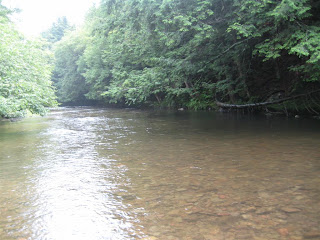
BEFORE

AFTER
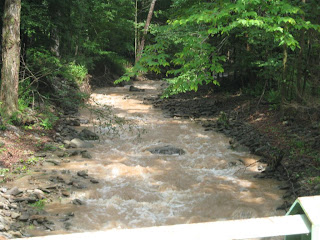
A Trib about 2 hours after the rain
The tribs on the Beaverkill and Willow really took a beaten in last weeks flood, there are piles of stone and debris, some which are 3 feet higher than the main river, at their creek mouths...Be careful when wading, I noticed alot of changes to flows and pools!!
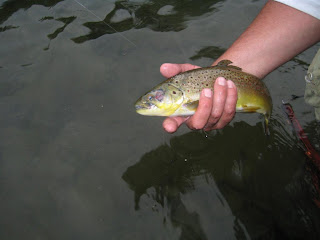
A Willowemoc Brown from the No-KIll
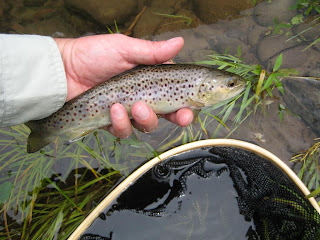
An Upper Willow Brown
The next morning the Beaverkill was still running brown, so I hit the no-kill section on the Willow...Again the fish were cooperative in the heavy water..I was fishing a high floating size 12 attractor with a beadhead Pheasant tail dropper...I missed a few fish in the fast water, and landed a few nice owns before lunch..It was equal between the dry and the nymph but I landed more that were hooked with the nymph...Black Clouds and Lightning chased me off the river, so I took refuge in the Catskill Flyfishing Museum and it was a good choice because I was stuck there for at least a 45 minutes as the skies just opened up...
We were wishing for rain, but this is just too much!
The Museum
Afterwards the Lower Willowemoc was unfishable, all the tribs were dumping liquid mud into the river..I drove upstream in hopes of finding some clear water and once I got above Debruce I found some fishable water...Like the morning, The fish seemed eager to feed and I landed another handful of fish, all small browns, on the tandem dry/nymph rig. At this point the sky was blue and the sun was out but I could still hear thunder in the distance...All of a sudden I noticed the water getting darker and faster. It was like I was fishing a tailwater and someone opened up all the gates..A few minutes later I was standing in thigh deep brown water and wished I had a wading staff...I bailed out and hiked back to the truck....
BEFORE
AFTER
A Trib about 2 hours after the rain
The tribs on the Beaverkill and Willow really took a beaten in last weeks flood, there are piles of stone and debris, some which are 3 feet higher than the main river, at their creek mouths...Be careful when wading, I noticed alot of changes to flows and pools!!

A Willowemoc Brown from the No-KIll
An Upper Willow Brown
